
* The Soviet Union lagged the West in jet aircraft development at the end of World War II. Such a deficiency was intolerable to Soviet dictator Josef Stalin, and development of jet combat aircraft was given high priority, resulting in progress that startled the West.
The aviation design bureau under Alexander Yakovlev was a leader in the development of first generation Soviet jet fighters. Aircraft such as the Yak-15, Yak-17, and Yak-23 provided useful service to Soviet forces and paved the way for more advanced aircraft. Yakovlev also developed a number of other experimental single-engined fighters that did not reach production. This document describes Yakovlev's early single-engine jet fighters.
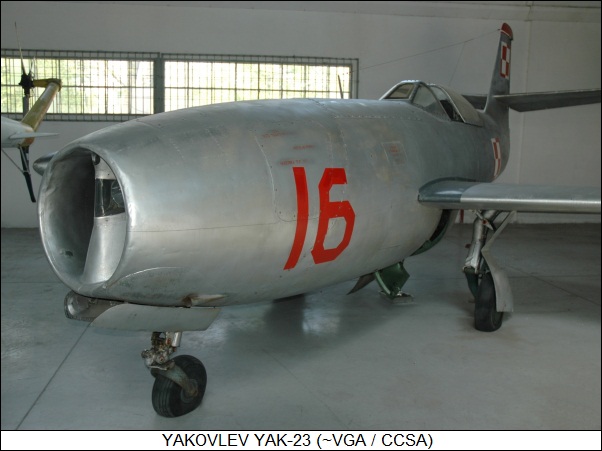
* The Soviet Union was in such a hurry to field a jet fighter at the end of the Second World War that the idea of using the Yakovlev bureau to actually manufacture a copy of the German Messerschmitt Me 262 was seriously considered. However, Yakovlev and his engineers came back with an alternate proposal that made more sense. The Yak-3 lightweight piston fighter had proven highly adaptable, and they proposed to fit one of the Me 262's Junkers Jumo 004B axial-flow turbojets to the Yak-3 in place of the aircraft's piston engine. Use of existing Yak-3 assemblies would simplify and speed up manufacture and introduction to operation.
The new aircraft was approved and designated "Yak-15", with first flight on 24 April 1946, piloted by Mikhail Ivanov. The Yak-15 was the second Soviet jet to fly after the first flight of the Mikoyan MiG-9 earlier that same day, and entered service with the VVS (Voyenno Vozdushniye Sily / Red Air Force) in 1947. It was powered by an RD-10 turbojet, a Soviet-built copy of the Jumo 004B, with 8.83 kN (900 kgp / 1,980 lbf) thrust. The Yak-15 was armed with a pair of Nudelman-Suranov NS-23 23-millimeter cannon in the top of the nose, with 60 rounds per gun.
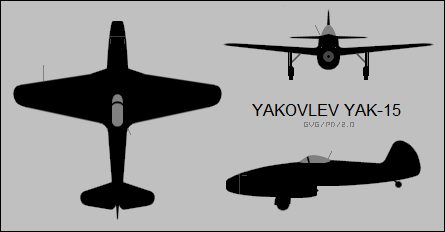
The Yak-15 was clearly an improvisation, with the jet engine grafted on underneath the nose of the fighter, so that the engine exhaust was directly below the cockpit. The Soviets referred to this as the "redan (stepped)" configuration. The fighter's underbelly was sheathed in stainless steel to protect it from the exhaust heat, and since the aircraft had a tailwheel landing configuration, the tailwheel was a metal roller to protect it from the exhaust flow.
However inelegant the Yak-15 may have been, the Soviet Union now had an operational jet fighter whose performance pushed 800 KPH (500 MPH), faster than any pure piston fighter the USSR possessed, and which inherited much of the Yak-3's legendary agility. In fact, it was one of the lightest jet fighters ever built.
_______________________________________________________________
YAKOVLEV YAK-15:
_______________________________________________________________
wingspan:
9.20 meters (30 feet 2 inches)
wing area:
14.85 sq_meters (160 sq_feet)
length:
8.70 meters (28 feet 6 inches)
height:
2.27 meters (7 feet 5 inches)
empty weight:
1,920 kilograms (4,230 pounds)
max loaded weight:
2,235 kilograms (5,810 pounds)
maximum speed:
805 kph (500 mph / 435 kt)
service ceiling:
13,350 meters (43,800 feet)
range:
510 kilometers (320 miles / 275 NMI)
_______________________________________________________________
Although the Yak-15 was an interim type, 280 had been manufactured by the time production terminated in March 1948, with all aircraft built by State Factory 31 at Tbilisi in Georgia. The plant had already been producing Yak-3s and moving production to the Yak-15 was relatively straightforward. One prototype of an unarmed tandem-seat trainer based on the Yak-15 was built, being designated the "Yak-21", but no production followed.
The Yak-15 gave the VVS valuable experience in jet fighter operations, in particular because its commonality with the piston-powered Yak-3 made conversion from prop to jet relatively straightforward. The aircraft was said to be too unreliable for field operations, possibly because the RD-10 engine inherited the notoriously short operational life of the Jumo 004B of about ten to twenty hours. The Yak-15 was also flown by several Soviet allies, including North Korea. NATO assigned it the reporting name "Feather".
* Although Soviet society tended toward the heavily bureaucratic, in some cases procedures were developed that made a good deal of sense. One such good practice was a system where aircraft manufacturers received regular feedback from the military services to suggest refinements for their products. Such feedback led to a redesign of the Yak-15, originally emerging as the "Yak-15U" prototype, where "U" stood for "Ulutschshennyi / Improved". A more refined prototype emerged as the "Yak-17", which performed its initial flight in May 1947, going into production later that year. NATO retained the reporting name "Feather" for the Yak-17.
The steel roller used for a tailwheel in the Yak-15 worked poorly, and of course tailwheel aircraft with long noses tended to give pilots a poor view forward while taxiing. The Yak-17 used a tricycle landing gear configuration, with the nosewheel retracting into a fairing under the nose, there being no space to fit it inside.
The Yak-17 also had a larger tailfin and rudder; replaced most of the wooden parts with metal parts; and used an uprated RD-10A engine, providing 9.8 kN (1,000 kgp / 2,200 lbf) of thrust. Reconfiguring the aircraft reduced internal fuel tankage, but the wings were reinforced to carry wingtip fuel tanks. Armament was the same as that of the Yak-15 -- twin NS-23 23-millimeter cannon. Due to the increase in weight, speed and climb were inferior to that of the Yak-15. It only remained in service for a very short time before being replaced by the much more advanced swept-wing Mikoyan MiG-15.
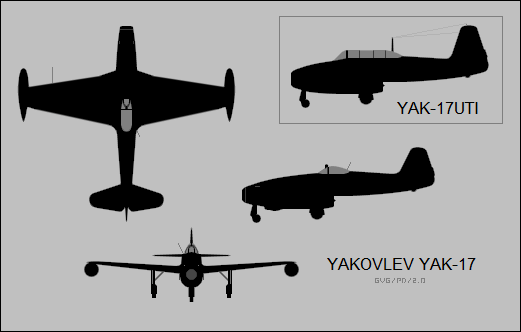
* The Yak-17 was the basis for a two-seat trainer, the "Yak-17UTI", with a longer fuselage and tandem cockpit. It was usually unarmed, but some were fitted with a single Berezin 12.7-millimeter machine gun -- almost certainly for weapons training, since such armament was too light to be effective for combat duty.
430 Yak-17s were built at Tbilisi, most being the Yak-17UTI trainer, the Yak-17 not really being seen as a satisfactory combat aircraft. The Yak-17UTI was given the NATO reporting name "Magnet", and remained in service until it was replaced by the two-seat Mikoyan MiG-15UTI "Midget" tandem-seat trainer. The Yak-17UTI also saw limited service with Poland, Czechoslovakia, Romania, and China.
BACK_TO_TOP* While the Soviets pressed forward with advanced jet fighter designs such as the MiG-15, they continued refinement of older designs as insurance. Yakovlev OKB engineers decided to come up with a new fighter design on their own, with state authorities then sanctioning development of the new fighter, the "Yak-23", in 1947, and the first of two prototypes performing its initial flight in July of that year.
The Yak-23 was a follow-on to the Yak-15 and Yak-17 that featured the same "redan" configuration. However, the Yak-23 was a "clean sheet of paper" redesign that retained little more than the general configuration of its predecessors. The Yak-23 featured all-metal construction; a new wing design obtained from the short-lived Yak-19 project, see below; a tailplane raised to the middle of the tailfin; fully retractable tricycle landing gear; and an RD-500 centrifugal-flow turbojet, which was a copy of a British Rolls-Royce Derwent V, with 15.7 kN (1,600 kgp / 3,525 lbf) thrust.
The Yak-23 was armed with two Nudelman-Suranov NS-23 23-millimeter cannon, firing from below the air intake, with 90 rounds per gun. It could carry a 190-liter (50 US gallon) drop tank on each wingtip. It was also one of the first Soviet fighters to be equipped with an ejection seat.
_______________________________________________________________
YAKOLEV YAK-23:
_______________________________________________________________
wingspan:
8.73 meters (28 feet 8 inches)
wing area:
13.5 sq_meters (145.3 sq_feet)
length:
8.12 meters (26 feet 8 inches)
height:
3.31 meters (10 feet 10 inches)
empty weight:
1,980 kilograms (4,365 pounds)
max loaded weight:
3,384 kilograms (7,460 pounds)
maximum speed:
885 kph (550 mph / 480 kt)
service ceiling:
14,800 meters (48,600 feet)
range with tanks:
1,200 kilometers (746 miles)
_______________________________________________________________
Early Yak-23 prototypes actually used imported British Derwent V engines. Initial flights were in June 1947, and production followed in 1948, with first operational deliveries in 1949. The MiG-15 proved successful, and so the Red Air Force had no real use for the Yak-23. Only two VVS air regiments were equipped with the type, but it was produced in larger numbers to equip Warsaw Pact forces. A total of 310 was built, to serve with Albania, Bulgaria, Czechoslovakia, Hungary, Poland, and Romania. Czechoslovak Yak-23s were given the designation "S-101". The Poles and Czechoslovaks made plans to produce the Yak-23 themselves, but eventually built the MiG-15 instead.
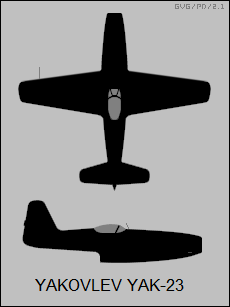
Although somewhat awkward in appearance and outclassed in speed by newer swept-wing aircraft, the Yak-23 was very agile, and its high power-to-weight ratio gave it an excellent rate of climb, with one establishing an international climb record in 1957. Warsaw Pact pilots liked the Yak-23, finding it something along the lines of a classic roadster car, with the type giving them their first experience in flying jet fighters. It was given the NATO reporting name "Flora".
* The Yak-23 was handed ground-attack duties later in its career, being fitted with improved Nudelman-Richter NR-23 23-millimeter cannon, and hardpoints for carrying up to a tonne (1.1 tons) of bombs or rockets. A single two-seat "Yak-23UTI" trainer was converted from a stock Yak-23 by the OKB, with the Romanians also performing a similar tandem-seat conversion, though there were no production Yak-23 trainers. The Yak-23 was also used for early trials of afterburning engines. It was generally out of service by the mid-1950s.
BACK_TO_TOP* While the Yakovlev OKB was redesigning the Yak-15 to come up with the Yak-17, a parallel effort was underway to develop a more advanced jet fighter aircraft, the "Yak-19". The Yak-19 was a classic "flying stovepipe" design, with inlet in the nose, exhaust in the tail, and straight wings with a laminar flow airfoil -- roughly in the same mold as the American Republic F-84 Thunderjet, though the Yak fighter was substantially smaller.
Two prototypes of the Yak-19 were built, with the first of the two flying in January 1947. They were powered by an RD-10F afterburning turbojet, with 10.8 kN (1,100 kgp / 2,425 lbf) thrust. The Yak-19 was one of the first Soviet aircraft to possess an afterburner. It also featured twin Nudelman-Suranov NS-23 23-millimeter cannon mounted under the nose intake, with 150 rounds per gun; tricycle landing gear; and an ejection seat. The second prototype differed from the first in having redesigned tail surfaces, and provision for 200-liter (53 US gallon) wingtip drop tanks.
_______________________________________________________________
YAKOVLEV YAK-19:
_______________________________________________________________
wingspan:
8.7 meters (28 feet 6 inches)
wing area:
13.5 sq_meters (145.3 sq_feet)
length:
8.36 meters (27 feet 5 inches)
empty weight:
2,190 kilograms (4,830 pounds)
normal loaded weight:
3,050 kilograms (6,725 pounds)
maximum speed:
907 kph (564 mph / 490 kt)
service ceiling:
12,100 meters (39,700 feet)
range:
550 kilometers (340 miles)
_______________________________________________________________
However, afterburning engines were a new thing at the time, and problems were unsurprisingly encountered with the RD-10F engine. Since more reliable and powerful engines were becoming available, the Yak-19 was canceled in August 1947.
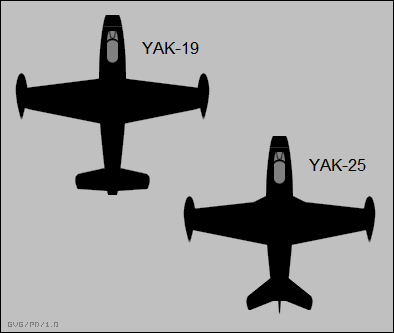
* The design concepts and engineering for the short-lived Yak-19 were adapted to an improved fighter, designated "Yak-25", built in response to a state requirement issued in 1947. The Yak-25 was developed in parallel with the Yak-23 and used the same Derwent V engine. Although the Derwent had a substantially larger diameter than the RD-10F used in the Yak-19, the Yak-25 used much the same fuselage.
The Yak-25 differed from the Yak-19 most visibly in having sweptback, not straight, tail surfaces. The Yak-25 also had a new straight laminar-flow wing that provided higher performance; and had three NR-23 23-millimeter cannon, not the twin cannon of the Yak-19, with 75 rounds per gun. Like the Yak-19, the Yak-25 could carry a 200-liter (53-US gallon) drop tank on each wingtip.
_______________________________________________________________
YAKOVLEV YAK-25:
_______________________________________________________________
wingspan:
8.88 meters (29 feet 2 inches)
wing area:
14.0 sq_meters (150.7 sq_feet)
length:
8.65 meters (28 feet 4 inches)
empty weight:
2,285 kilograms (5,040 pounds)
normal loaded weight:
3,235 kilograms (7,130 pounds)
maximum speed:
1,090 kph (675 mph / 590 kt)
service ceiling:
12,000 meters (39,370 feet)
range:
1,445 kilometers (900 miles)
_______________________________________________________________
Two Yak-25 prototypes were built, the first flying on 31 October 1947. The initial tail configuration led to severe buffeting, and so work was done on a new tail configuration. However, all interest for serious development of the Yak-25 quickly faded out, work having moved on to more ambitious designs, and so the two prototypes ended up as trials machines.
One was fitted with a nose probe to allow it to be towed by a Tupolev Tu-4 bomber, a Soviet copy of the US Boeing B-29 Superfortress. The scheme, known as "burlaki (barge hauler)", envisioned a bomber hauling its own escorts into a combat area, dragging them through the air on cables, and then releasing them when approaching the target. The idea was ultimately dismissed as impractical, the pilot tending to freeze while being hauled along with the bomber with the engine shut down, while hooking back up to a bomber after action was problematic. The "Yak-25" designation would later be recycled for a twin-jet interceptor that did see service.
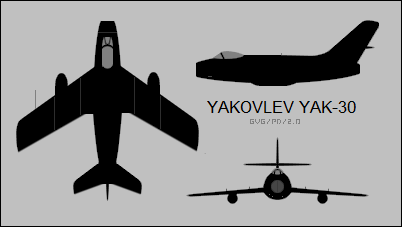
* The Yak OKB had lost interest in the Yak-25 because focus had moved on to the more refined machine, the "Yak-30". The Yak-30 was designed in response to a March 1946 request for a "frontal" fighter with a top level speed of Mach 0.9, and the ability to operate from unimproved airfields. The Yak-30 essentially took the Yak-25 fuselage with few changes, fitted with a new RD-500 / Derwent V engine offering 15.6 kN (1,590 kgp / 3,500 lbf) thrust, and traded the straight wings for sweptback wings with a 35 degree leading-edge sweep and a 2-degree anhedral droop. There were two "fences" on each wing to keep airflow from migrating down the length of the wing and reducing lift. Wingtip tanks were no longer practical with the new arrangement, so underwing tanks were carried instead. The three NR-23 cannon were retained. The result was strikingly similar to the MiG-15.
_______________________________________________________________
YAKOVLEV YAK-30:
_______________________________________________________________
wingspan:
8.65 meters (28 feet 4 inches)
wing area:
15.1 sq_meters (162.24 sq_feet)
length:
8.58 meters (28 feet 2 inches)
empty weight:
2,415 kilograms (5,325 pounds)
normal loaded weight:
3,330 kilograms (7,340 pounds)
maximum speed:
1,030 kph (640 mph / 560 kt)
service ceiling:
15,000 meters (49,200 feet)
range with drop tanks:
1,720 kilometers (1,070 miles)
_______________________________________________________________
Two Yak-30 prototypes were flown. The first took to the air on 4 September 1948. The second prototype, the "Yak-30D", flew in 1949, featuring a number of changes such as a 38-centimeter (15-inch) fuselage stretch behind the wing to accommodate more fuel; air brakes; revised main landing gear doors; an enhanced flap arrangement; greater fuel and ammunition capacity; and minor changes to the oxygen system and radio gear. However, the Yak-30 proved inferior to the MiG-15, and so the project was abandoned.
* In 1949, the VVS issued a requirement for a night / all-weather fighter. The Yak OKB responded with the "Yak-50", which incorporated Yak-30 experience, but was a generally new and somewhat larger aircraft. While the Yak-50's had a swept wing configuration similar to that of the Yak-30 -- though with leading-edge sweep increased to 45 degrees, and three wing fences on each wing instead of two -- the Yak-50 had a radome for Korshun air-intercept radar in the upper lip of the jet intake; and a "bicycle" style landing gear arrangement, with tandem main gear in the fuselage and outriggers on each wingtip. One of the Yak-25 prototypes had been modified to test this landing gear configuration.
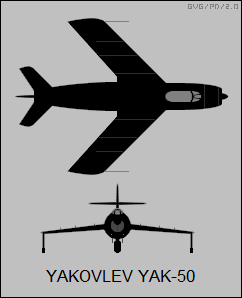
The Yak-50 was one of the first Soviet fighters to make extensive use of magnesium in its construction. It was powered by a Klimov VK-1 engine -- a copy of an imported British Rolls-Royce Nene centrifugal-flow turbojet -- with 26.5 kN (2,700 kgp / 5,950 lbf) thrust, and was armed with twin NS-23 23-millimeter cannon with 80 rounds per gun.
_______________________________________________________________
YAKOVLEV YAK-50:
_______________________________________________________________
wingspan:
7.98 meters (26 feet 2 inches)
wing area:
16.0 sq_meters (172.23 sq_feet)
length:
11.2 meters (36 feet 9 inches)
empty weight:
3,125 kilograms (6,890 pounds)
max loaded weight:
4,155 kilograms (9,160 pounds)
maximum speed:
1,125 kph (700 mph / 610 kt)
service ceiling:
16,050 meters (52,600 feet)
range:
1,100 kilometers (685 MI / 595 NMI)
_______________________________________________________________
Two prototypes were built, the first flying on 15 July 1949. The Yak-50 had excellent near-sonic performance and could take off and land on relatively short runways, but the bicycle landing gear proved treacherous in crosswinds and even more so under wet conditions; the aircraft also suffered from oscillations at top speed that interfered with gun aiming. By this time, the MiG OKB was offering the potentially superior MiG-17P all-weather fighter, and the Yak-50 was abandoned, as had been its ancestors.
BACK_TO_TOP* Two other single-engine Yak jet fighters were built, but neither ever got off the ground. The first, the "Yak-1000", began life in a 1950 state requirement for a fighter using the new Arkhip Lyulka AL-5 axial-flow turbojet, to feature a top speed of Mach 1.7 -- a really aggressive goal, considering that at the time no production aircraft was capable of breaking Mach 1 in level flight.
The Yak-1000 was to use a strongly-swept short-span cropped delta wing, with a leading-edge sweep of 60 degrees, and a tailplane with a similar configuration, along with bicycle landing gear. Aerodynamically, the configuration was new territory; when the AL-5 program was delayed, the decision was made to fly a demonstrator powered by the RD-500 centrifugal-flow turbojet.
The demonstrator was rolled out in early 1951. It had a length of 11.69 meters (38 feet 4 inches) without its nose probe, a span of only 4.59 meters (15 feet 1 inch), and a maximum takeoff weight of about 2,400 kilograms (5,300 pounds). It began taxi trials in the spring, but instabilities cropped up that ended up taking the aircraft off the runway, badly damaging it. Some work was done to fix the machine, but it was clearly unpromising, and was abandoned, unflown, before the end of the year.
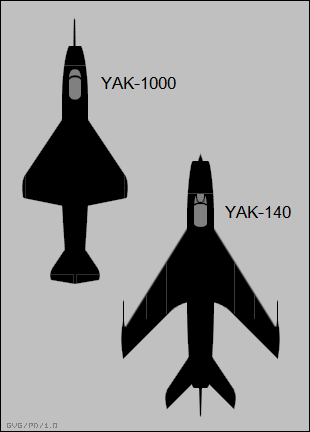
* The second, the "Yak-140", was a considerably improved follow-on to the Yak-50. It featured an afterburning Tumanskiy AM-9D axial-flow turbojet, providing 47.6 kN (4,850 kgp / 10,692 lbf) thrust. The AM-9D was much slimmer than the centrifugal-flow VK-1 engine used on the Yak-50, allowing a slenderer fuselage. The Yak-140 had a circular inlet in the nose with a moveable inlet cone, and mid-mounted wings with 55.5 degree leading-edge sweepback.
The Yak-140 had a length of 13.34 meters (43 feet 9 inches), a span of 7.94 meters (26 feet), and a loaded weight of about 4,850 kilograms (10,690 pounds). It was armed with twin NR-23 23-millimeter cannon, with 100 rounds per gun. It looked somewhat like a Mikoyan MiG-21, but with swept wings instead of the MiG-21's delta wings, and also had the bicycle landing gear scheme; it was expected to be capable of Mach 1.5 or Mach 2. The single prototype was rolled out in late 1954, to begin taxi tests. That was as far as the project got -- it was canceled in early 1955 since the MiG-21 had been approved for production, rendering the Yak-140 redundant.
BACK_TO_TOP* Sources include:
* Revision history:
v1.0.0 / 01 mar 11 v1.1.0 / 01 jun 12 / Relocated Yak-30 & Yak-32 elsewhere. v1.1.1 / 01 mar 14 / Review & polish. v1.1.2 / 01 feb 16 / Review & polish. v1.1.3 / 01 jan 18 / Review & polish. v1.1.4 / 01 nov 19 / Review & polish. v1.1.5 / 01 sep 21 / Review & polish. v1.1.6 / 01 aug 23 / Review & polish. v1.1.7 / 01 aug 25 / Review & polish. (!)BACK_TO_TOP
